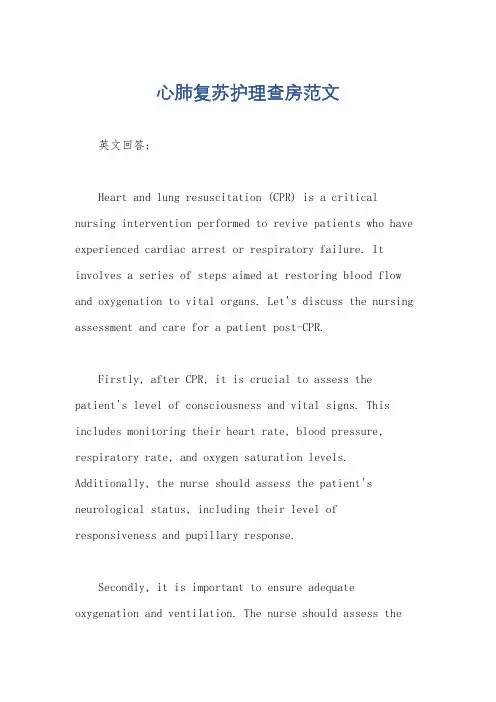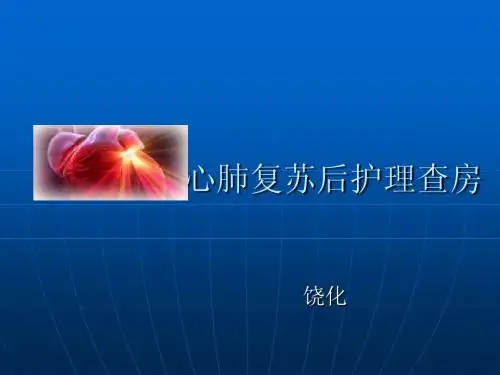心肺复苏术后护理查房
- 格式:ppt
- 大小:148.00 KB
- 文档页数:14


心肺复苏护理查房范文英文回答:Heart and lung resuscitation (CPR) is a critical nursing intervention performed to revive patients who have experienced cardiac arrest or respiratory failure. It involves a series of steps aimed at restoring blood flow and oxygenation to vital organs. Let's discuss the nursing assessment and care for a patient post-CPR.Firstly, after CPR, it is crucial to assess thepatient's level of consciousness and vital signs. This includes monitoring their heart rate, blood pressure, respiratory rate, and oxygen saturation levels. Additionally, the nurse should assess the patient's neurological status, including their level of responsiveness and pupillary response.Secondly, it is important to ensure adequate oxygenation and ventilation. The nurse should assess thepatient's breathing pattern and administer supplemental oxygen as needed. The patient may require endotracheal intubation and mechanical ventilation to maintain adequate oxygenation and ventilation.Thirdly, the nurse should monitor the patient's cardiac rhythm using a cardiac monitor. This allows for early detection of any dysrhythmias or changes in the patient's heart rate. If necessary, the nurse should be prepared to initiate appropriate interventions, such as defibrillation or administration of antiarrhythmic medications.Furthermore, the nurse should closely monitor the patient's fluid and electrolyte balance. This includes assessing the patient's urine output, serum electrolyte levels, and fluid intake and output. Intravenous fluids may be administered to maintain adequate hydration and electrolyte balance.Additionally, the nurse should provide emotional support and reassurance to the patient and their family. CPR can be a traumatic experience, and patients and theirloved ones may need guidance and counseling to cope withthe aftermath.In conclusion, post-CPR care involves a comprehensive nursing assessment and interventions to ensure thepatient's stability and recovery. Close monitoring of vital signs, oxygenation, cardiac rhythm, fluid balance, and emotional support are essential components of this care.中文回答:心肺复苏(CPR)是一种紧急的护理干预措施,用于挽救心脏骤停或呼吸衰竭的患者。




心肺复苏后病人护理查房目录CONTENCT •心肺复苏概述•心肺复苏后的护理要点•心肺复苏后并发症的预防与处理•心肺复苏后病人的营养与康复•心肺复苏后护理查房的实施与管理01心肺复苏概述心肺复苏的定义心肺复苏是指在心脏骤停的情况下,采取一系列急救措施,以恢复患者的自主心跳和呼吸。
心肺复苏包括胸外按压、开放气道和人工呼吸等步骤,目的是在心脏骤停后的黄金时间内尽快恢复患者的生命体征。
0102心肺复苏的重要性在心脏骤停发生后,脑组织对缺氧非常敏感,快速恢复脑供血是避免脑死亡的关键。
心肺复苏是抢救心脏骤停患者的关键措施,及时有效的心肺复苏可以显著提高患者的生存率。
心肺复苏的历史与发展心肺复苏技术自20世纪50年代开始发展,经过不断改进和完善,已经成为急救医学中的重要组成部分。
02心肺复苏后的护理要点010203监测心率、呼吸、血压、体温等指标,及时发现并处理异常情况。
定期记录生命体征数据,绘制趋势图,为医生提供诊断依据。
观察病人意识状态,评估病人认知和感知能力。
生命体征监测保持呼吸道通畅,及时清理呼吸道分泌物。
观察病人呼吸频率、深度和节奏,评估呼吸功能。
根据需要使用氧气吸入,调整氧流量,确保血氧饱和度正常。
呼吸道管理监测心电图,观察心律和心电波形。
评估病人血液循环状态,观察皮肤颜色、温度和湿度。
根据病情调整输液速度和量,维持水电解质平衡。
循环系统管理根据医嘱正确使用药物,确保药物剂量和给药时间准确。
观察病人对药物的反应,及时处理不良反应。
记录用药情况,为医生提供药物治疗效果反馈。
药物治疗与护理心理护理与康复指导关注病人心理状态,给予心理支持和疏导。
评估病人认知和情感状况,进行必要的康复训练和指导。
指导病人进行日常生活活动和功能锻炼,促进康复。
03心肺复苏后并发症的预防与处理脑水肿与颅内压增高的预防与处理总结词脑水肿和颅内压增高是心肺复苏后的常见并发症,可能导致脑组织损伤和死亡。
详细描述密切监测病人的意识状态、瞳孔变化和生命体征,尤其是颅内压的变化。




